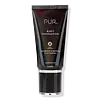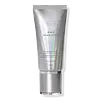What's inside
What's inside
 Key Ingredients
Key Ingredients

 Benefits
Benefits

 Concerns
Concerns

 Ingredients Side-by-side
Ingredients Side-by-side

Water
Skin ConditioningDimethicone
EmollientPentylene Glycol
Skin ConditioningPolymethylsilsesquioxane
Polysilicone-11
Glycerin
HumectantButylene Glycol
HumectantCeramide AP
Skin ConditioningRetinol
Skin ConditioningLactic Acid
BufferingButyrospermum Parkii Butter
Skin ConditioningSodium Starch Octenylsuccinate
AbsorbentPanax Ginseng Root Extract
EmollientCamellia Sinensis Leaf Extract
AntimicrobialNiacinamide
SmoothingCharcoal Powder
AbrasiveBuddleja Officinalis Flower Extract
UV FilterPolyacrylate-13
Polyisobutene
Caprylyl Glycol
EmollientHydroxyethylcellulose
Emulsion StabilisingPropanediol
SolventPolysorbate 20
EmulsifyingAlteromonas Ferment Filtrate
HumectantPotassium Sorbate
PreservativeDecyl Glucoside
CleansingHexylene Glycol
EmulsifyingSodium Hydroxide
BufferingCitric Acid
BufferingPhenoxyethanol
PreservativeDisodium Phosphate
BufferingPolysorbate 60
EmulsifyingSodium Phosphate
BufferingWater, Dimethicone, Pentylene Glycol, Polymethylsilsesquioxane, Polysilicone-11, Glycerin, Butylene Glycol, Ceramide AP, Retinol, Lactic Acid, Butyrospermum Parkii Butter, Sodium Starch Octenylsuccinate, Panax Ginseng Root Extract, Camellia Sinensis Leaf Extract, Niacinamide, Charcoal Powder, Buddleja Officinalis Flower Extract, Polyacrylate-13, Polyisobutene, Caprylyl Glycol, Hydroxyethylcellulose, Propanediol, Polysorbate 20, Alteromonas Ferment Filtrate, Potassium Sorbate, Decyl Glucoside, Hexylene Glycol, Sodium Hydroxide, Citric Acid, Phenoxyethanol, Disodium Phosphate, Polysorbate 60, Sodium Phosphate
Water
Skin ConditioningCeteareth-6 Olivate
EmulsifyingCoconut Alkanes
EmollientNeopentyl Glycol Dicaprylate/Dicaprate
EmollientHydrogenated Olive Oil
Skin ConditioningPropanediol
SolventSqualane
EmollientCocos Nucifera Water
MaskingCocos Nucifera Fruit Juice
EmollientLactobacillus
Skin ConditioningAloe Barbadensis Leaf Juice
Skin ConditioningCaffeine
Skin ConditioningGlycyrrhiza Uralensis Root Extract
Skin ConditioningCeramide AP
Skin ConditioningRetinol
Skin ConditioningLactic Acid
BufferingButyrospermum Parkii Butter
Skin ConditioningSodium Starch Octenylsuccinate
AbsorbentGlycerin
HumectantPolyacrylate Crosspolymer-6
Emulsion StabilisingCoco-Caprylate/Caprate
EmollientOlea Europaea Fruit Oil
MaskingTrisodium Ethylenediamine Disuccinate
Olea Europaea Oil Unsaponifiables
Skin ConditioningCaprylic/Capric Triglyceride
MaskingAnanas Sativus Fruit Extract
Skin ConditioningCoffea Arabica Leaf/Seed Extract
MaskingJasminum Officinale Flower/Leaf Extract
MaskingDipteryx Odorata Seed Extract
MaskingCocos Nucifera Fruit Extract
EmollientPrunus Armeniaca Fruit Extract
Skin ConditioningCucumis Melo Cantalupensis Fruit Extract
AstringentVanilla Planifolia Fruit Extract
Skin ConditioningCitrus Aurantium Dulcis Peel Extract
Emulsion StabilisingPhenoxyethanol
PreservativeHexylene Glycol
EmulsifyingCaprylyl Glycol
EmollientSodium Benzoate
MaskingPotassium Sorbate
PreservativeWater, Ceteareth-6 Olivate, Coconut Alkanes, Neopentyl Glycol Dicaprylate/Dicaprate, Hydrogenated Olive Oil, Propanediol, Squalane, Cocos Nucifera Water, Cocos Nucifera Fruit Juice, Lactobacillus, Aloe Barbadensis Leaf Juice, Caffeine, Glycyrrhiza Uralensis Root Extract, Ceramide AP, Retinol, Lactic Acid, Butyrospermum Parkii Butter, Sodium Starch Octenylsuccinate, Glycerin, Polyacrylate Crosspolymer-6, Coco-Caprylate/Caprate, Olea Europaea Fruit Oil, Trisodium Ethylenediamine Disuccinate, Olea Europaea Oil Unsaponifiables, Caprylic/Capric Triglyceride, Ananas Sativus Fruit Extract, Coffea Arabica Leaf/Seed Extract, Jasminum Officinale Flower/Leaf Extract, Dipteryx Odorata Seed Extract, Cocos Nucifera Fruit Extract, Prunus Armeniaca Fruit Extract, Cucumis Melo Cantalupensis Fruit Extract, Vanilla Planifolia Fruit Extract, Citrus Aurantium Dulcis Peel Extract, Phenoxyethanol, Hexylene Glycol, Caprylyl Glycol, Sodium Benzoate, Potassium Sorbate
Alternatives
Ingredients Explained
These ingredients are found in both products.
Ingredients higher up in an ingredient list are typically present in a larger amount.
This ingredient is also known as shea butter. It is an effective skin hydrator and emollient.
Emollients help soothe and soften your skin. It does this by creating a protective film on your skin. This barrier helps trap moisture and keeps your skin hydrated. Emollients may be effective at treating dry or itchy skin.
Shea butter is rich in antioxidants. Antioxidants help fight free-radicals, or molecules that may harm the body. It is also full of fatty acids including stearic acid and linoleic acid. These acids help replenish the skin and keep skin moisturized.
While Shea Butter has an SPF rating of about 3-4, it is not a sunscreen replacement.
Shea butter may not be fungal acne safe. We recommend speaking with a professional if you have any concerns.
Learn more about Butyrospermum Parkii ButterCaprylyl Glycol is a humectant and emollient, meaning it attracts and preserves moisture.
It is a common ingredient in many products, especially those designed to hydrate skin. The primary benefits are retaining moisture, skin softening, and promoting a healthy skin barrier.
Though Caprylyl Glycol is an alcohol derived from fatty acids, it is not the kind that can dry out skin.
This ingredient is also used as a preservative to extend the life of products. It has slight antimicrobial properties.
Learn more about Caprylyl GlycolCeramide AP is formally known as Ceramide 6.
Ceramides are intercellular lipids naturally found in our skin that bonds dead skin cells together to create a barrier. Having a strong skin barrier leads to more firm and hydrated skin.
They are known for their ability to hold water and thus are a great ingredient for dry skin. By bolstering the skin ceramides act as a barrier against irritating ingredients. This can help with inflammation as well.
If you would like to eat ceramides, sweet potatoes contain a small amount.
Read more about other common types of ceramides here:
Ceramide NP
Ceramide EOP
Glycerin is already naturally found in your skin. It helps moisturize and protect your skin.
A study from 2016 found glycerin to be more effective as a humectant than AHAs and hyaluronic acid.
As a humectant, it helps the skin stay hydrated by pulling moisture to your skin. The low molecular weight of glycerin allows it to pull moisture into the deeper layers of your skin.
Hydrated skin improves your skin barrier; Your skin barrier helps protect against irritants and bacteria.
Glycerin has also been found to have antimicrobial and antiviral properties. Due to these properties, glycerin is often used in wound and burn treatments.
In cosmetics, glycerin is usually derived from plants such as soybean or palm. However, it can also be sourced from animals, such as tallow or animal fat.
This ingredient is organic, colorless, odorless, and non-toxic.
Glycerin is the name for this ingredient in American English. British English uses Glycerol/Glycerine.
Learn more about GlycerinHexylene Glycol is a surfactant. Glycols are a class of alcohols. Hexylene Glycol is a surfactant and emulsifier.
As a surfactant, Hexylene Glycol helps gather dirt and oil on your skin to be washed away.
As an emulsifier, Hexylene Glycol helps keep water and oil together. This prevents them from separating in a product. Hexylene Glycol also thins out the texture of a product by lessening viscosity.
Hexylene Glycol has a small molecular weight.
Learn more about Hexylene GlycolLactic Acid is another well-loved alpha hydroxy acid (AHA). It is gentler than glycolic acid but still highly effective.
Its main role is to exfoliate the surface of the skin by loosening the “glue” that holds dead skin cells together. Shedding those old cells leads to smoother, softer, and more even-toned skin.
Because lactic acid molecules are larger than glycolic acid, they don’t penetrate as deeply. This means they’re less likely to sting or irritate, making it a great choice for beginners or those with sensitive skin.
Like glycolic acid, it can:
Lactic acid also acts as a humectant (like hyaluronic acid). It can draw water into the skin to improve hydration and also plays a role in the skin's natural moisturizing factor (NMF) in the form of sodium lactate.
Studies show it can boost ceramide production to strengthen the skin barrier and even help balance the skin’s microbiome.
To get results, choose products with a pH between 3-4.
Lower strengths (5-12%) focus on surface exfoliation; higher strengths (12% and up) can reach deeper in the dermis (deeper, supportive layer) to improve skin texture and firmness over time.
Though it was originally derived from milk, most modern lactic acid used in skincare is vegan. It is made through non-dairy fermentation to create a bio-identical and stable form suitable for all formulations.
When lactic acid shows up near the end of an ingredient list, it usually means the brand added just a tiny amount to adjust the product’s pH.
Legend has it that Cleopatra used to bathe in sour milk to help reduce wrinkles.
Lactic acid is truly a gentle multitasker: it exfoliates, hydrates, strengthens, and brightens. It's a great ingredient for giving your skin a smooth, glowing, and healthy look without the harshness of stronger acids.
Read more about some other popular AHA's here:
Learn more about Lactic AcidPhenoxyethanol is a preservative that has germicide, antimicrobial, and aromatic properties. Studies show that phenoxyethanol can prevent microbial growth. By itself, it has a scent that is similar to that of a rose.
It's often used in formulations along with Caprylyl Glycol to preserve the shelf life of products.
Potassium Sorbate is a preservative used to prevent yeast and mold in products. It is commonly found in both cosmetic and food products.
This ingredient comes from potassium salt derived from sorbic acid. Sorbic acid is a natural antibiotic and effective against fungus.
Both potassium sorbate and sorbic acid can be found in baked goods, cheeses, dried meats, dried fruit, ice cream, pickles, wine, yogurt, and more.
You'll often find this ingredient used with other preservatives.
Learn more about Potassium SorbatePropanediol is an all-star ingredient. It softens, hydrates, and smooths the skin.
It’s often used to:
Propanediol is not likely to cause sensitivity and considered safe to use. It is derived from corn or petroleum with a clear color and no scent.
Learn more about PropanediolRetinol is a gold-standard ingredient for anti-aging. It is a form of Vitamin A and belongs to the class of retinoids that also includes tretinoin.
Why is retinol famous?
It has the most scientific studies backing up its skin benefits out of all the non-prescription ingredients.
Retinol is proven to:
This is why retinol is effective at removing wrinkles, fading dark spots, treating acne, and reducing the appearance of pores.
Studies show retinol is less effective when exposed to UV. Be sure to look for appropriate packaging to keep your retinol potent (similar to Vitamin C).
Using retinol or any retinoids will increase sun-sensitivity in the first few months. Though studies show retinoids increase your skin's natural SPF with continuous use, it is best to always wear sunscreen and sun-protection.
We recommend speaking with a medical professional about using this ingredient during pregnancy.
Retinol may cause irritation in some people, so be sure to patch test. Experts recommend 'ramping up' retinol use: start using this ingredient once a week and work up to using it daily.
Read about Tretinoin
Learn more about RetinolWe don't have a description for Sodium Starch Octenylsuccinate yet.
Water. It's the most common cosmetic ingredient of all. You'll usually see it at the top of ingredient lists, meaning that it makes up the largest part of the product.
So why is it so popular? Water most often acts as a solvent - this means that it helps dissolve other ingredients into the formulation.
You'll also recognize water as that liquid we all need to stay alive. If you see this, drink a glass of water. Stay hydrated!
Learn more about Water